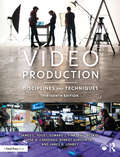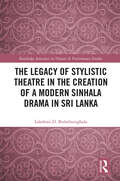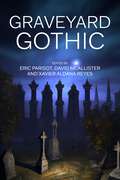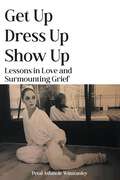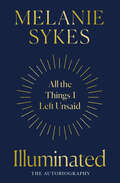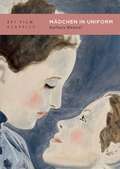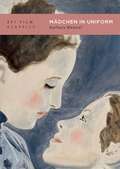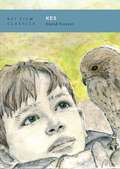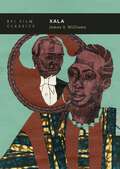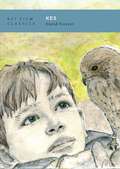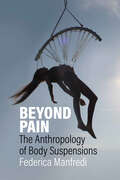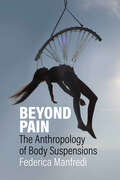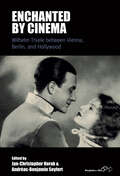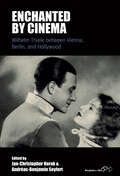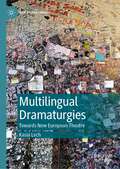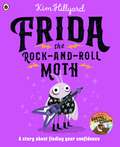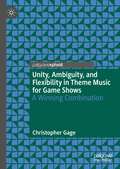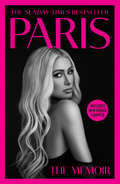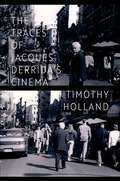- Table View
- List View
Video Production: Disciplines and Techniques
by James C. Foust Edward J. Fink Phil Beskid Jose A. Cardenas Robert Gordon Jr. James B. LohreyThis seminal text, now in its thirteenth edition, provides a comprehensive and accessible overview of the operations underlying video production.It provides thorough coverage of the theory and techniques readers need to know, balancing complexity with practical how-to information about detailed subjects in a concise, conversational style. The book has been updated to incorporate recent changes in the video production pipeline–emphasizing digital video, non-linear video production, streaming platforms, mobile production, and do-it-yourself video–while maintaining the foundational, nuanced, teamwork-based approach that has made the book popular.Chapters include key takeaways, review questions, on-set exercises, and QR codes, and a comprehensive glossary defines all the key production terms discussed. An accompanying eResource includes downloadable versions of the forms and paperwork used in the book, in addition to links to further online resources.
The Gentleman Dancing-Master: Mr Isaac and the English Royal Court from Charles II to Queen Anne (Clemson University Press: Studies in British Musical Cultures)
by Jennifer ThorpThe Gentleman Dancing-Master: Mr Isaac and the English Royal Court from Charles II to Queen Anne is a study of the life of the most significant dancing-master at the late-Stuart court in London. It discusses his use of dance music and brings together, for the first time, reprints of the notations of all his twenty-three surviving dances created for performance at court in the presence of the monarch, including several created to celebrate the birthdays of Queen Anne or named after important courtiers or political events. This study highlights the significance of dance as a central part of court culture, and also the wider context of the London book trade within which Isaac’s notators turned his dances into a publishable form ultimately taken over by John Walsh’s music publishing firm. Using extensive archival and printed sources from his day, the book follows Isaac’s career as a dancer, teacher, and choreographer of sophisticated duets in the fashionable French style, some of which were also performed in the theatre. Isaac, however, was no slavish follower of French fashion, and by careful consideration of the extant dances from the point of view of a dancer, this study also seeks to throw light on Isaac’s often individualistic approach to choreography.
The Legacy of Stylistic Theatre in the Creation of a Modern Sinhala Drama in Sri Lanka (ISSN)
by Lakshmi D. BulathsinghalaThis book explores the development of Sinhala stylistic drama from its earliest manifestations to the post-independence era.Bulathsinghala examines the impact of indigenous and imported folk theatrical forms on the work of the most significant postcolonial stylistic dramatists and on key plays that they produced. In the process, the book explores a number of myths and misunderstandings regarding Sri Lanka’s folk heritage and seeks to establish more reliable information on the principal indigenous Sri Lankan folk dramatic forms and their characteristics. At the same time, by drawing connections between folk drama and the post-independence stylistic theatrical movement, the author demonstrates the essential role of the former in Sinhala culture prior to the advent of Western and other influences and shows how both continue to inflect Sri Lankan drama today.This book will help to open the field of South Asian drama studies to an audience consisting not only of scholars and students but also of general readers who are interested in the fields of drama and theatre and Asian studies.
The Legacy of Stylistic Theatre in the Creation of a Modern Sinhala Drama in Sri Lanka (ISSN)
by Lakshmi D. BulathsinghalaThis book explores the development of Sinhala stylistic drama from its earliest manifestations to the post-independence era.Bulathsinghala examines the impact of indigenous and imported folk theatrical forms on the work of the most significant postcolonial stylistic dramatists and on key plays that they produced. In the process, the book explores a number of myths and misunderstandings regarding Sri Lanka’s folk heritage and seeks to establish more reliable information on the principal indigenous Sri Lankan folk dramatic forms and their characteristics. At the same time, by drawing connections between folk drama and the post-independence stylistic theatrical movement, the author demonstrates the essential role of the former in Sinhala culture prior to the advent of Western and other influences and shows how both continue to inflect Sri Lankan drama today.This book will help to open the field of South Asian drama studies to an audience consisting not only of scholars and students but also of general readers who are interested in the fields of drama and theatre and Asian studies.
Graveyard Gothic
by Eric Parisot, David McAllister and Xavier Aldana ReyesGraveyard Gothic is the first sustained consideration of the graveyard as a key Gothic locale. This volume examines various iterations of the Gothic graveyard (and other burial sites) from the eighteenth century to the twenty-first, as expressed in numerous forms of culture and media including poetry, fiction, TV, film and video games. The volume also extends its geographic scope beyond British traditions to accommodate multiple cultural perspectives, including those from the US, Mexico, Japan, Australia, India and Eastern Europe. The seventeen chapters from key international Gothic scholars engage a range of theoretical frameworks, including the historical, material, colonial, political and religious. With a critical introduction offering a platform for further scholarship and a coda mapping potential future critical and cultural developments, Graveyard Gothic is a landmark volume defining a new area of Gothic studies.
Graveyard Gothic
by Eric Parisot David McAllister Xavier Aldana ReyesGraveyard Gothic is the first sustained consideration of the graveyard as a key Gothic locale. This volume examines various iterations of the Gothic graveyard (and other burial sites) from the eighteenth century to the twenty-first, as expressed in numerous forms of culture and media including poetry, fiction, TV, film and video games. The volume also extends its geographic scope beyond British traditions to accommodate multiple cultural perspectives, including those from the US, Mexico, Japan, Australia, India and Eastern Europe. The seventeen chapters from key international Gothic scholars engage a range of theoretical frameworks, including the historical, material, colonial, political and religious. With a critical introduction offering a platform for further scholarship and a coda mapping potential future critical and cultural developments, Graveyard Gothic is a landmark volume defining a new area of Gothic studies.
Get Up, Dress Up, Show Up: Lessons in Love and Surmounting Grief
by Petal Ashmole WinstanleyThis book is about surviving grief, and charts a journey of exceptional love. Now, aged 77, the burden of ambition has left the author and she has, with the help of close confidantes, reconfigured her life. Petal Ashmole Winstanley grew up in Perth, Western Australia with two great loves: her mother and classical ballet. Spurred on by her natural talent and ambition to dance, she made the voyage on the SS Canberra to London in the swinging '60s-the start of a vibrant career encompassing the glamour, global travel and trials and tribulations of a life on the stage. Her journey has been one of creative fulfilment often offset by deep sadness and loss: that of a longed-for baby, and the ultimate grief of losing three husbands. Petal speaks with gut-wrenching honesty of the brutal circumstances leading to each of their deaths, and the heartbreaking aftermath of a grief that would not ease. Repeated hospice experiences allow her to share an intimate knowledge of what happens before, during and after death-and have made her an advocate for early AIDS and cancer detection, and a fierce believer in Dignity in Dying. Sometimes shocking but frequently funny, Petal's story of sorrow is peppered with optimism as she recounts how, even at the gates of hell, she found the strength to get up, dress up and show up, sporting a dash of red lipstick.
Illuminated: Autism & All The Things I’ve left Unsaid
by null Melanie SykesThe impactful and empowering memoir from Melanie Sykes Melanie Sykes has been a face on our screens, a voice on our radios for nearly thirty years. As a presenter and broadcaster people turned to her for her humour, her honesty and insight. But between all the interviews and chat shows, is a life unseen, a story unsaid. Her journey – from up north to down south, from Manchester to LA and via London, Paris and India, and through the eye of the storm of celebrity culture is a rollercoaster ride. Sex, drugs and rock and roll, certainly, but also brass bands and ice cream vans, broken hearts and healing adventures – a search not for fame but for freedom. Her autism diagnosis in midlife has supercharged that journey – and means this isn’t a story just of breakdown, but of breakthrough. Funny, furious and gloriously frank, this is a book that lifts the lid on being a woman in the media, navigating relationships, and being a neurodivergent person speaking up in a neurotypical world. Illuminated is Melanie, in her own inimitable voice.
Mädchen in Uniform (BFI Film Classics)
by Barbara MennelLeontine Sagan's Mädchen in Uniform (1931) is a groundbreaking German film that showcases women's agency and desire behind and in front of the camera.Adapted from Christa Winsloe's lesbian play, the story follows Manuela, an orphan in a boarding school for impoverished Prussian nobility. When she declares her love with her female teacher, the oppressive principal punishes her, leading to a desperate suicide attempt.Barbara Mennel's compelling study firmly establishes Mädchen in the Weimar cinema canon. Mennel contextualises the film in 1920s theories of sexuality and the conventions of modernist cinema. She contrasts its international success to the extensive censorship battles that surrounded it. The film's unique transnational and fragmented history results from the exile of many of its makers during the Nazi regime. By attending to the many remakes throughout the 20th and 21st century, Mennel underscores the film's timeless impact that continues to resonate with contemporary audiences.
Mädchen in Uniform (BFI Film Classics)
by Barbara MennelLeontine Sagan's Mädchen in Uniform (1931) is a groundbreaking German film that showcases women's agency and desire behind and in front of the camera.Adapted from Christa Winsloe's lesbian play, the story follows Manuela, an orphan in a boarding school for impoverished Prussian nobility. When she declares her love with her female teacher, the oppressive principal punishes her, leading to a desperate suicide attempt.Barbara Mennel's compelling study firmly establishes Mädchen in the Weimar cinema canon. Mennel contextualises the film in 1920s theories of sexuality and the conventions of modernist cinema. She contrasts its international success to the extensive censorship battles that surrounded it. The film's unique transnational and fragmented history results from the exile of many of its makers during the Nazi regime. By attending to the many remakes throughout the 20th and 21st century, Mennel underscores the film's timeless impact that continues to resonate with contemporary audiences.
Kes (BFI Film Classics)
by David ForrestKen Loach's 1969 drama Kes, considered one of the finest examples of British social realism, tells the story of Billy, a working class boy who finds escape and meaning when he takes a fledgling kestrel from its nest.David Forrest's study of the film examines the genesis of the original novel, Barry Hines' A Kestrel for a Knave (1968), the eventual collaboration that brought it to the screen, and the film's funding and production processes. He provides an in depth analysis of key scenes and draws on archival sources to shed new light on the film's most celebrated moments. He goes on to consider the film's lasting legacy, having influenced films like Ratcatcher (1999) and This is England (2006), both in terms of its contribution to film history and as a document of political and cultural value. He makes a case for the film's renewed relevance in our present era of systemic economic (and regional) inequality, alienated labour, increasingly narrow educational systems, toxic masculinity, and ecological crisis. Kes endures, he argues, because it points towards the possibility for emancipation and fulfilment through a more responsive and nurturing approach to education, a more delicate and symbiotic relationship with landscape and the non-human, and an emotional articulacy and sensitivity shorn of the rigid expectations of gender.
Xala (BFI Film Classics)
by James S. WilliamsXala (1974) by the pioneering Senegalese director Ousmane Sembene, was acclaimed on its release for its scorching critique of postcolonial African society, and it cemented Sembene's status as a wholly new kind of politically engaged, pan-African, auteur film-maker. Centring on the story of businessman El Hadji and the impotence that afflicts him on his marriage to a young third wife, Xala vividly captures the cultural and political upheaval of 1970s Senegal, while suggesting the radical potential of dissent, solidarity and collective action, embodied by El Hadji's student daughter Rama and the group of urban 'undesirables' who act as a kind of raw chorus to the affairs of the neocolonial elite. James S. Williams's lucid study traces Xala's difficult production history and analyses its daring combination of political and domestic drama, oral narrative, social realism, symbolism, satire, documentary, mysticism and Marxist analysis. Yet from its dazzling extended opening sequence of revolution as performance to its suspended climax of redemption through ritualised spitting, Xala presents a series of conceptual and formal challenges that resist a simple reading of the film as allegory. Highlighting often overlooked elements of Sembene's intricate, experimental film-making, including provocative shifts in mood and poetic, even subversively erotic, moments, Williams reveals Xala as a visionary work of both African cinema and Third Cinema that extended the parameters of postcolonial film practice and still resounds today with its searing inventive power.
Xala (BFI Film Classics)
by James S. WilliamsXala (1974) by the pioneering Senegalese director Ousmane Sembene, was acclaimed on its release for its scorching critique of postcolonial African society, and it cemented Sembene's status as a wholly new kind of politically engaged, pan-African, auteur film-maker. Centring on the story of businessman El Hadji and the impotence that afflicts him on his marriage to a young third wife, Xala vividly captures the cultural and political upheaval of 1970s Senegal, while suggesting the radical potential of dissent, solidarity and collective action, embodied by El Hadji's student daughter Rama and the group of urban 'undesirables' who act as a kind of raw chorus to the affairs of the neocolonial elite. James S. Williams's lucid study traces Xala's difficult production history and analyses its daring combination of political and domestic drama, oral narrative, social realism, symbolism, satire, documentary, mysticism and Marxist analysis. Yet from its dazzling extended opening sequence of revolution as performance to its suspended climax of redemption through ritualised spitting, Xala presents a series of conceptual and formal challenges that resist a simple reading of the film as allegory. Highlighting often overlooked elements of Sembene's intricate, experimental film-making, including provocative shifts in mood and poetic, even subversively erotic, moments, Williams reveals Xala as a visionary work of both African cinema and Third Cinema that extended the parameters of postcolonial film practice and still resounds today with its searing inventive power.
Kes (BFI Film Classics)
by David ForrestKen Loach's 1969 drama Kes, considered one of the finest examples of British social realism, tells the story of Billy, a working class boy who finds escape and meaning when he takes a fledgling kestrel from its nest.David Forrest's study of the film examines the genesis of the original novel, Barry Hines' A Kestrel for a Knave (1968), the eventual collaboration that brought it to the screen, and the film's funding and production processes. He provides an in depth analysis of key scenes and draws on archival sources to shed new light on the film's most celebrated moments. He goes on to consider the film's lasting legacy, having influenced films like Ratcatcher (1999) and This is England (2006), both in terms of its contribution to film history and as a document of political and cultural value. He makes a case for the film's renewed relevance in our present era of systemic economic (and regional) inequality, alienated labour, increasingly narrow educational systems, toxic masculinity, and ecological crisis. Kes endures, he argues, because it points towards the possibility for emancipation and fulfilment through a more responsive and nurturing approach to education, a more delicate and symbiotic relationship with landscape and the non-human, and an emotional articulacy and sensitivity shorn of the rigid expectations of gender.
Beyond Pain: The Anthropology of Body Suspensions
by Federica ManfrediThe practice of body suspension — piercing one’s own flesh with metal hooks and hanging from them — and its uniquely sprawling community challenge our cultural understanding of pain. The suspendees experience physical suffering to trigger altered states of consciousness that help them define and create an enhanced version of the self. Through experimental and practice-based methodology, Beyond Pain combines thirteen years of intermittent ethnographical fieldwork during suspension festivals and private events in Italy, Portugal, and Norway, along with online sites such as Facebook groups, to uncover the often silenced and misunderstood voices of the people who undertake this practice.
Beyond Pain: The Anthropology of Body Suspensions
by Federica ManfrediThe practice of body suspension — piercing one’s own flesh with metal hooks and hanging from them — and its uniquely sprawling community challenge our cultural understanding of pain. The suspendees experience physical suffering to trigger altered states of consciousness that help them define and create an enhanced version of the self. Through experimental and practice-based methodology, Beyond Pain combines thirteen years of intermittent ethnographical fieldwork during suspension festivals and private events in Italy, Portugal, and Norway, along with online sites such as Facebook groups, to uncover the often silenced and misunderstood voices of the people who undertake this practice.
Enchanted by Cinema: Wilhelm Thiele between Vienna, Berlin, and Hollywood (Film Europa #29)
by Jan-Christopher Horak Andréas-Benjamin SeyfertWilliam Thiele is remembered today as the father of the sound film operetta with seminal classics such as Drei von der Tankstelle (1930). While often considered among the most accomplished directors of Late Weimar cinema, as an Austrian Jew he was vilified during the onset of the Nazi regime in 1933 and fled to the United States where he continued making films until the end of his career in 1960. Enchanted by Cinema closely examines the European musical film pioneer’s work and his cross-cultural perspective across forty years of filmography in Berlin and Hollywood to account for his popularity while discussing issues of ethnicity, exile, comedy, music, gender, and race.
Enchanted by Cinema: Wilhelm Thiele between Vienna, Berlin, and Hollywood (Film Europa #29)
by Jan-Christopher Horak Andréas-Benjamin SeyfertWilliam Thiele is remembered today as the father of the sound film operetta with seminal classics such as Drei von der Tankstelle (1930). While often considered among the most accomplished directors of Late Weimar cinema, as an Austrian Jew he was vilified during the onset of the Nazi regime in 1933 and fled to the United States where he continued making films until the end of his career in 1960. Enchanted by Cinema closely examines the European musical film pioneer’s work and his cross-cultural perspective across forty years of filmography in Berlin and Hollywood to account for his popularity while discussing issues of ethnicity, exile, comedy, music, gender, and race.
Beyond Pain: The Anthropology of Body Suspensions
by Federica ManfrediThe practice of body suspension — piercing one’s own flesh with metal hooks and hanging from them — and its uniquely sprawling community challenge our cultural understanding of pain. The suspendees experience physical suffering to trigger altered states of consciousness that help them define and create an enhanced version of the self. Through experimental and practice-based methodology, Beyond Pain combines thirteen years of intermittent ethnographical fieldwork during suspension festivals and private events in Italy, Portugal, and Norway, along with online sites such as Facebook groups, to uncover the often silenced and misunderstood voices of the people who undertake this practice.
Enchanted by Cinema: Wilhelm Thiele between Vienna, Berlin, and Hollywood (Film Europa #29)
by Jan-Christopher Horak and Andréas-Benjamin SeyfertWilliam Thiele is remembered today as the father of the sound film operetta with seminal classics such as Drei von der Tankstelle (1930). While often considered among the most accomplished directors of Late Weimar cinema, as an Austrian Jew he was vilified during the onset of the Nazi regime in 1933 and fled to the United States where he continued making films until the end of his career in 1960. Enchanted by Cinema closely examines the European musical film pioneer’s work and his cross-cultural perspective across forty years of filmography in Berlin and Hollywood to account for his popularity while discussing issues of ethnicity, exile, comedy, music, gender, and race.
Multilingual Dramaturgies: Towards New European Theatre (New Dramaturgies)
by Kasia LechMultilingual Dramaturgies provides a study of dramaturgical practices in contemporary multilingual theatre in Europe. Featuring interviews with international theatremakers, the book gives an insight into diverse approaches towards multilingual theatre and its dramaturgy that reflect cultural, political, and economic landscapes of contemporary Europe, its inhabitants, and its theatres. First-hand accounts are contextualized to reveal a complex set of negotiations involved in the creative and political tasks of staging multilingualism and engaging the audience, as well as in practical issues like funding and developing working models. Using interviews with practitioners from a diverse range of theatrical backgrounds and career levels, and with various models of financial support, Multilingual Dramaturgies also offers an insight into different attitudes towards multilingualism in European theatres. The book illuminates not only the potential for multilingual dramaturgies, but also the practical and creative difficulties involved in making them. By bringing the voices of artists together and providing a critical commentary, the book reveals multilingual dramaturgies as webbed practices of differences that also offer new ways of understanding and performing identity in a European context. Multilingual Dramaturgies sheds light on an exciting theatre practice, argues for its central role in Europe and highlights potential directions for its further development.
Frida the Rock-and-Roll Moth: A story about finding your confidence
by Kim HillyardA NEW picture book from the winner of the Best Illustrated Book, Waterstones Children's Prize 2023.Frida is a musical moth who loves to rock out - she puts on her pointy boots and plays her purple guitar really LOUD! But when the Big Bright Light is switched on, more moths appear, ready to rock together, and Frida starts to feel that everyone is much better than her. Perhaps she isn't so rock-and-roll after all . . .With the help of her biggest fan, Auntie Edna, Frida learns to reclaim her style, find her confidence and get up and rock on once more!This positive picture book will inspire readers to find what makes them feel good and let their inner confidence shine.Kim Hillyard creates positive, heart-warming stories that are designed to empower and inspire young readers. Each picture book focuses on a different feeling or belief to help children navigate the world around them.Also available from Kim Hillyard:Mabel and the Mountain: a story about believing in yourselfNed and the Great Garden Hamster Race: a story about kindnessGretel The Wonder Mammoth: a story about overcoming anxietyFlora and Nora Hunt for Treasure: a story about the power of friendship
Unity, Ambiguity, and Flexibility in Theme Music for Game Shows: A Winning Combination
by Christopher GageWith flashing lights, bright colors, and big money, game shows have been an integral part of American culture since the days of radio. While the music that accompanies game shows is charming and catchy, it presents two unique, opposing challenges: first, it must exhibit unity in its construction so that, at any point and for any length of time, it is a tuneful, recognizable signifier of the show to which it belongs; at the same time, it must also possess the ability to be started and stopped according to the needs of gameplay without seeming truncated. This book argues that game show music, in particular from 1960 to 1990, deploys a variety of shared techniques in order to manage these two goals, including theme-derived vamps; saturation of motivic material; and harmonic, rhythmic, and formal ambiguity. Together, these techniques make game show themes exciting, memorable, and perfectly suited to their role.
Paris: The Memoir
by null Paris HiltonPARIS: A MILLION MEANINGS IN A SINGLE NAME Heiress. Party girl. Problem child. Selfie taker. Model. Reality star. Self-created. The labels attached to Paris Hilton. Founder. Entrepreneur. Pop Culture Maker. Innovator. Survivor. Activist. Daughter. Sister. Wife. Mother. The roles Paris embraces as a fully realized woman. Paris rose to prominence as an heiress to the Hilton hotel empire but cultivated her fame and fortune as the IT Girl of the aughts, a time marked by the burgeoning 24-hour entertainment news cycle and the advent of the celebrity blog. Using her celebrity brand, Paris set in motion her innovative business ventures, while being the constant target of tabloid culture that dismissively wrote her off as “famous for being famous.” With tenacity, sharp business acumen and grit, she built a global empire and, in the process, became a truly modern icon beloved around the world. Now, with courage, honesty, and humour, Paris Hilton is ready to take stock, place it all in context and share her story with the world. Separating the creation from the creator, the brand from the ambassador, Paris: The Memoir strips away all we thought we knew about a celebrity icon, taking us back to a privileged childhood lived through the lens of undiagnosed ADHD, a teenage rebellion that triggered a panicked – and perilous – decision by her parents. Led to believe they were saving their child’s life, Paris’s mother and father had her kidnapped and saw her sent to a series of ‘emotional growth boarding schools’, where she survived almost two years of verbal, physical and sexual abuse. In the midst of a hell we now call the ‘troubled teen industry’, Paris created a beautiful inner world where the ugliness couldn’t touch her. She came out, resolving to trust no-one but herself as she transformed that fantasy world into a multibillion-dollar reality. Recounting her perilous journey through pre-#MeToo sexual politics with grace, dignity and just the right amount of sass. Paris: The Memoir tracks the evolution of celebrity culture through the story of the figure at its leading edge, full of defining moments and marquee names. Most important, Paris shows us her path to peace while she challenges us to question our role in her story and in our own. Welcome to Paris.
The Traces of Jacques Derrida's Cinema
by Timothy HollandSituated at the intersection of film and media studies, literary theory, and continental philosophy, The Traces of Jacques Derrida's Cinema provides a trenchant account of the role of cinema in the oeuvre of one of the most influential philosophers of the twentieth century, Jacques Derrida (1930-2004). The book is animated by Derrida's self-confessed passion for the movies, his reluctance to write about film despite the range of his corpus, and the generative encounters arising between his legacy and the field of film and media studies as a result. Given the expanse of its references, interdisciplinarity, and consideration of Derrida's approach to the experience of both spectatorship and the act of being filmed, The Traces of Jacques Derrida's Cinema contributes to the ongoing close analyses of the philosopher's work while also providing a rigorous introduction to deconstruction. Author Timothy Holland interweaves historical and speculative modes of research and writing to articulate the peripheral-yet surprisingly crucial-place of the cinematic medium for Derrida and his philosophical enterprise. The outcome is a meticulously detailed survey of the centers and margins of Derrida's oeuvre that include forays into such terrain as: his notable appearances in films; an unrealized project on cinema and belief that Derrida proposed in a 2001 interview; the correspondences between the strategies of deconstruction and the traditions, homecomings, and wordplay of David Lynch's cinematic media; and the questions wedded to the future of film studies amid the vicissitudes of the modern, virtual university. Ultimately, Holland pursues the thinking activated by the flickering of Derrida's cinema-not only the absence and presence of film in Derrida's professional and personal life, but also the rigor of academic discourse and the pleasures of the movies, ghosts and technology, religious faith and scientific knowledge, and ruination and survival-as a critical chance for reflection.
